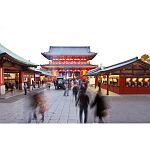If you have a few hours to spare between flights at Delhi and you already have an Indian visa, you can make a quick sortie to enjoy your own Delhi city tour instead of hanging around the airport. And the shopping is better too!
Half – Day Tour: North into Old Delhi, 3-4 hours
From New Delhi metro station head north through one of the ancient city gates, Ajmere Gate, and onto the street called Chawri Bazar, lined with small shops specialising in brass, copper and paper souvenirs (you would bargain hard here). Navigate to the Jama Masjidmosque by looking up for its minarets which you can see from everywhere. Jama Masjid is one of largest mosques in Asia and you can climb one of the minaret towers for great views of Old Delhi (note that women have to put on one of the long garments handed out at the entrance).
From here head north east past the Lahore Gate to Red Fort – a huge, sprawling red fortress, once the residence and headquarters of the Mughal Emperors, now home to a bazaar and the Indian War Memorial with exhibitions of guns, swords and armour. The rest of the complex is a military barracks now, and much of it is off-limits – Agra Fort is much more interesting to visit if you are heading to the Taj Mahal.
Leading west from Red Fort is Chandni Chowk street, lined with small shops and crisscrossed by lanes that specialise in particular goods such as silver jewellery such as along Dariba Kalan, paper and books at Nai Sarak and so on. As you walk along Chandni Chowk there isDigambar Jain temple with its bird hospital, the Sikh Shauri Gankarand Sisganj temples, and at the end is Fatehpur Mosque. Beyond here you arrive at Khari Baoli spice market which is the largest wholesale spice market in Asia. If you’re tired by now, hop in a tuk-tuk and head to the historic Oberoi Maidens Hotel for refreshment in stylish surroundings. The concierge there will help you hire a taxi or a tuk-tuk to return to New Delhi metro station to get back to the airport.
Half Day: South into New Delhi, 3-4 hours
FabIndia andAnokhi both sell stylish, good quality and very affordable east-meets-west clothes and homewares, whilst Central Cottage Industries Emporium in block N has 6 floors of all sorts of goods that make excellent presents and souvenirs.
If you go round Connaught Place and exit to the south you will come toJantar Mantar, the first open-air observatory built in 1724 by Maharaja Jai Singh II of Jaipur who later built the much better one in Jaipur, and you can admire the large stone instruments placed to observe the heavens and make astronomical calculations. Call at the legendaryImperial Hotel for refreshments if you have time on the way down to Rajpath, the road running east to west that connects India Gate, the symbol of New Delhi, with Rashtrapati Bhavan, once home of the Viceroy, now the largest Presidential Palace in the world. India Gate is a 42m high stone arch inspired by the Arc de Triomphe in Paris. It bears the name of the 85,000 Indian Army soldiers who died in the campaigns of WW1, the North-West Frontiers operations and the 1919 Afghan war, and below the arch is the memorial to the unknown soldier. You may prefer just to pass by the palace and India Gate, or get your taxi or tuk-tuk to do a circle so you can take pictures.
From here you can continue further south by tuk-tuk to upmarket Khan Market where you can find bookshops, tailors, good food, silver jewellery, shops such as FabIndia and Anokhi as well as the big western brands, or to Lodhi Gardens. These shady gardens surround the crumbling tombs of the 15th century rulers of India and make for a pleasant respite from the city. From Lodhi or Khan market you can then continue to Humayun’s Tomb built in the mid 16th century of red sandstone in the traditional Mughal architectural style, set amidst peaceful gardens.
From here, you really should be heading back to the airport unless you have loads more time for shopping and sightseeing and a car to travel in, in which case, there are a couple more great markets stretching south from Lodhi gardens, the first being Lodhi colony main marketlocated in a former war infirmary in an upmarket suburb, where Indian designers offer luxury fashion in distinctive surroundings. Further south again is Dilli Haat, an open air arts and crafts market where you can buy direct from the artisans who rent one of the stalls for a fortnight at a time. And further again is Haus Khaz Village, an arty, upmarket suburb with boutiques, galleries and restaurants, very pleasant to explore on foot and with some old monuments scattered around. Continuing south you will arrive at Qutab Minar, the Afgan victory tower, the highest stone tower in India at 238ft high dating from the 12th century. From here, your car can take you back to Indira Gandhi Airport.
The best way to enjoy a carefree sightseeing or day tour of Delhi is to hire a private guide, car and driver to meet you at the airport, take you and your luggage and shopping around and return you safely and on time for your onward flight. ReadyClickAndGo can arrange city or shopping tours in Delhi to suit your interests, budget and timetable.














